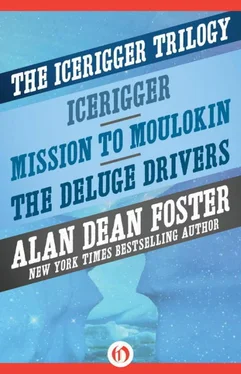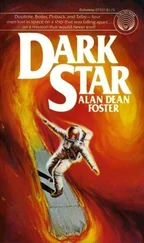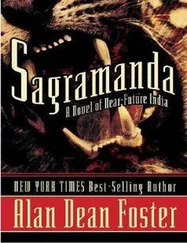Like everyone else, the cries had roused Ethan from his cabin and sent him running to the deck to learn what all the shouting was about. As he snapped his suit closed he noticed sailors up in the rigging taking in sail.
“What is it, Skua?” he shouted at the giant as he ran to the railing. Then he didn’t have to ask because he saw it for himself.
As though cleft by the axe of a god, the cliffs had been split from rim to ice just off the port bow. As they drew nearer, the extent of the chasm could be estimated. Ethan guessed it was not quite two hundred meters across. It maintained that width as far down the canyon as he could see.
There was no sign of a city, but there were numerous signs of its nearness. September leaned over the railing, pointed wordlessly down to the ice.
Despite the light dusting of ice particles and snow, Ethan could clearly make out many sets of parallel grooves running through the smooth surface. They were the tracks of ships which had passed this way. While they crossed and cut over one another, all converged on the chasm in the plateau wall.
September, had his tiny monocular out. He’d flipped up the protective mask of the survival suit and was holding the compact telescope to one eye.
“What do you see, Skua?”
“Sheer rock, feller-me-lad. Rock no different from that forming the cliffs we’ve been pacing for weeks. Not a sail, not a building, nothing. Maybe the canyon takes a tight turn and hides the town.” He slipped the monocular back into the sealocket in his suit, squinted at the plateau. “One thing’s certain… all these tracks lead somewhere popular. I wonder at the clouds inland, though. Even if the wind’s less there, you wouldn’t think they’d linger so thick in one place.”
It did seem that the interior of the plateau immediately behind the canyon was home to a dense mass of oddly whitish clouds. Blue sky around and above made the cloud-forms stand out sharply. Ethan thought briefly of volcanic smoke, such as could be seen from Sofold’s steady-burning peaks. Only this smoke was much too light to be volcanic in origin.
“If it’s such a busy port, why don’t we see any other ships?”
“That gal Teeliam did say this Moulokin’s primarily a ship-building and manufacturing center. Poyolavomaar, Arsudun, Sofold—they’re all trading ports. Maybe no one visits here unless they’ve a finished raft waitin’ for them. Or maybe the Moulokinese are superstitious and only trade certain times of the year. Be interestin’ to see what they make of us.”
Cries sounded from the helmdeck immediately behind them. Ta-hoding was gesturing busily to mates and assistants. Gracefully, sails were drawn up and tied to spars. The Slanderscree continued its cautious approach to the canyon.
Something pressed against the face mask of Ethan’s survival suit. He raised it cautiously, then shut it fast. His suit thermometer indicated it was minus twenty outside, but it wasn’t the cold that made him hastily shield his skin.
They were traveling almost due east. That meant the untiring westwind was directly behind them. Yet they were making little progress. The icerigger rocked slightly, and he saw that Ta-hoding was tacking. That was crazy: nobody tacks away from the wind!
“Strong gale blowin’ down out of the canyon,” observed September with interest. A glance upward showed the sails flapping uncertainly against the spars. Occasionally the wind off the plateau was strong enough to shove pika-pina sail material back against the masts. At such moments the ship shuddered as if reluctant to continue. But under Ta-hoding’s careful and expert guidance, they kept making steady progress forward. Very soon they entered the mouth of the canyon.
Walls over a hundred meters high towered on both sides of the ice ship. As they progressed up the chasm, the sheer stone ramparts rose steadily higher, though the canyon showed no sign of narrowing.
At a hundred seventy meters high the cliffs leveled off, only then the canyon walls began to press inward slightly. There was less room to maneuver. Ta-hoding and his crew worked hard to keep the zig-zagging ship from smashing into unyielding canyon sides. He was making shorter and shorter tacks, threatening terribly if a sail crew was seconds too slow in shifting a spar.
Once, the sailors manipulating the foremast tops misinterpreted a mate’s order and swung their spars starboard instead of port. With a lurch, the Slanderscree continued on course to starboard instead of swinging around to cross the expanse of ice in the channel. Ethan stared, frozen, as they lumbered steadily toward the nearing gray cliff.
Sailors fought frantically to correct the error, compensate for the mistake. There was a dull, patient grinding noise. Fortunately the icerigger was now traveling so slowly into the headwind that the impact did no more than crack the railing and splinter a couple of deck planks.
The ease with which the planking splintered turned Ethan’s attention to the treeless rims high overhead. How stable were they? In the event of a slide there was no room to escape in the narrow confines of the canyon.
He was worrying needlessly again. The crash of ship into stone hadn’t loosened as much as a pebble from the clifftop.
Strong comments were relayed from helmdeck to foremast crew via the midship’s mate. They were intended to relax the atmosphere on board while chastising the foremast sailors. Instead, the invective only added to the general tension, did not produce the laughter it would have in less threatening surroundings.
The mystery of the mythic city-state, the narrowing canyon walls that shut out the clean sky, the skate-scarred ice they were traversing, in conjunction with their unfortunate experiences at Poyolavomaar, combined to test the mental stability of the crew. Ethan knew it would be better if they encountered something— hostile, friendly or even inexplicable—before many more minutes passed.
It occured to him to wonder what they would do if Moulokin proved as unreal as it had proven elusive and the canyon simply continued to narrow, perhaps to a lonely rock-face dead-end. The many ship tracks might signify nothing more than a convocation of religious worshippers at a favorite shrine, or indicate a well-used refuge from storms.
Such visitors would have no trouble turning their ships around and racing back down the ice-filled canyon with the inland wind at their backs. But the canyon was as narrow as the Slanderscree was long. She could not possibly be turned ’round in so slim a space. They might have to backsail, traveling stern-first and steering in a fashion unthought of.
September had theorized a bend in the canyon. All at once it turned sharply southward. The crew had to struggle with lines and spars to swing the icerigger safely around the twisting walls.
The wind continued to buffet them from off the plateau, but it was gentler now. The ice raft could proceed up canyon on a softer tack.
Except that the canyon was blocked.
At first he thought it a landslide, tumbled down from those cliffs so stable in appearance. As they drew nearer it was clear that the obstacle was Tran-made, its great stones and blocks neatly piled with mortarless masonry to form a wall stretching across the ice strait like a granite web.
It was perhaps thirty meters high, deeper than he could casually guess without a higher view. As was the custom on Tran-ky-ky, the colossal double gate was constructed of wood. It rose nearly as high as the stone walls themselves and was flanked on either side by a triangular tower.
The structure puzzled him. Impressive as they were, these could not be the gates to fabled Moulokin. Behind the barrier the cliffs rose high and close together as ever. There was no room for a city behind the wall. And if any such did exist there, he reminded himself, surely it could be seen from the lookout cage on the mainmast.
Читать дальше










